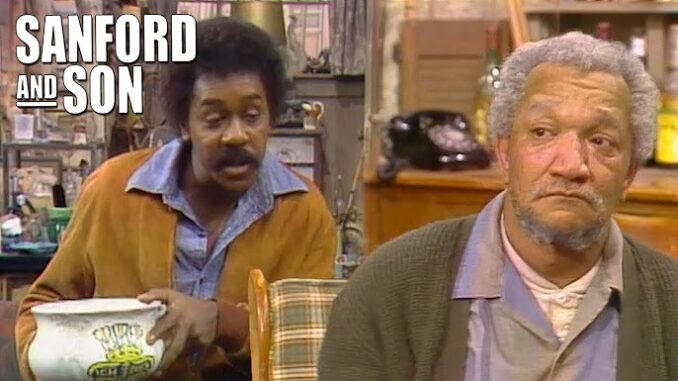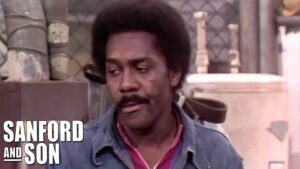
It was the second season that would see the arrival of Fred’s best known foil, Aunt Esther (LaWanda Page). In the first season Fred’s primary antagonist was Aunt Ethel (Beah Richards), who was constantly expressing her disapproval of the junk dealer. It was in the second season that she was replaced by Aunt Esther. Aunt Esther was the sister of Fred’s late wife Elizabeth and had never approved of the marriage. While Esther loves her nephew Lamont and he loves her as well, she has nothing but disdain for Fred. A devout Christian, she often calls him, “You old heathen!” Despite being a devout Christian, it was not unusual for her to threaten Fred with violence and she would even hit him with her purse from time to time. LaWanda Page, who played Esther, had met Redd Foxx when they were both still in elementary school in St. Louis. And like Redd Foxx, she would have a successful career in stand-up comedy. She had actually decided to leave show business when Redd Foxx asked her to audition for the role of Esther.
Lamont’s friend Rollo (Nathaniel Taylor) was also introduced in the second season. Rollo had spent time in jail, and so Fred remained convinced he was a criminal. What is more, Fred never missed a chance to remind Rollo of that fact. Nathaniel Taylor was also a former resident of St. Louis, and it was in part due to this fact that he was cast in the role of Rollo. It was also in the second season that Fred’s friend Bubba (Don Bexley) was introduced. Bubba was a jovial fellow who would eagerly take part in any of Fred’s get-rich-quick schemes. He always greeted Fred with a loud, bellowing, “Hey, Fred!,” something that not only got on Lamont’s nerves, but Fred’s as well. Like Redd Foxx and LaWanda Page, Don Bexley was also a stand-up comedian and he and Mr. Foxx had met while working as stand-up comedians.
Even though he is now closely associated with the show, Fred’s best friend Grady Wilson (Whitman Mayo) would not join Sanford and Son until the second episode of the third season. Grady was good-natured and easy going, but, not terribly bright. Like Bubba, he also often became involved in Fred’s get-rich-quick schemes. Grady was a devoted friend and his feelings could be easily hurt. Grady became one of the most popular characters on the show, so much he would eventually received his own spin-off series. Although Grady was in his sixties, at the time Whitman Mayo was playing him, he was only in his forties.
Among the other recurring characters was Julio Fuentes (Gregory Siera), Fred and Lamont’s Puerto Rican next door neighbour and fellow junk dealer. Fred would often hurl ethnic slurs at Julio and even say that he should return to Puerto Rico (even though Julio was from New York City). In contrast, Julio always remained friendly towards Fred. Despite constantly insulting Julio, Fred does seem to like him deep down in side. When a local elementary school wants to demote Julio’s nephew to a lower grade because he is not proficient in English, it is Fred who takes up for him. May Hopkins (Nancy Kulp), Officer Hoppy Hopkins’s mother, started appearing in the fifth season. She rents a room at the Sanford Arms, the boarding house that Fred and Lamont opened after Julio sold them his property and moved away.
Sanford and Son featured its share of famous guest stars. George Foreman, Lena Horne, B. B. King all guest starred as themselves. The show also featured such well known guest stars as Jack Carter, Scatman Crothers, Greg Morris, Frank Nelson, and Mary Wickes.
Sanford and Son continued to be a hit in its third season, coming in at no. 3 for the year. All would not run smoothly for NBC during that season. Despite being a show centred on a Black junk dealer and his son, the majority of writers on Sanford and Son were white. At the same time, the show was a huge hit and Redd Foxx was only receiving $19,000 per episode. Redd Foxx then demanded 25% ownership of the show. When his demands weren’t answered, he walked out. For the remaining six episodes of the third season, it was explained that Fred had gone to St. Louis to attend his cousin’s funeral. Grady then took over the running of the Sanford household. The success of these episodes featuring only Grady and Lamont would be part of the reason that Grady would receive his own spin-off. Grady had the character move in with his daughter’s family who lived in Westwood. The show debuted on December 4 1974. It did not repeat the success of Sanford and Son, lasting only ten episodes. After the spin-off ended, Grady returned to Sanford and Son.
As to Redd Foxx’s salary dispute, it resulted in a lawsuit from Tandem Productions. Eventually the salary dispute was resolved, with Redd Foxx receiving a raise of $25,000 per episode and 25% of the producers’ net profits. Redd Foxx then returned to the show for its fourth season.
That fourth season proved to be more successful than its third, with the show rising once more to no. 2 in the Nielsen ratings for the year. Sanford and Son would not maintain that level of success for long. It dropped to no. 7 for the year in its fifth season. In its sixth season it dropped to no. 27 for the year. Of course, coming in at no. 27 for the year was more than enough for NBC to renew the show, but circumstances would ultimately result in the show’s end. ABC drew Redd Foxx away from NBC with an offer of a multimillion dollar contract and his own variety show. Sanford and Son then ended with its sixth season. As it turned out, Redd Foxx might have wished he had remained with Sanford and Son. The Redd Foxx Comedy Hour only lasted from September 15 1977 to January 26 1978.
In attempt to salvage the situation, NBC decided to continue Sanford and Son after a fashion. Initially it was planned for Demond Wilson to star, but he left following a salary dispute. A new lead character was then introduced, Phil Wheeler (Theodore Wilson), an old friend of Fred, who bought the Sanford property after Fred and Lamont had moved to Arizona. Still appearing on the show were Esther, Bubba, and Grady. The focus of the show was shifted to the boarding house that Fred and Lamont had opened, the Sanford Arms. Sanford Arms did not last long. Although eight episodes were made, only four episodes aired before the show was cancelled.

While Sanford Arms was a failure, it was not the last that television would see of Fred Sanford. By 1979 NBC had fallen in its fortunes. It was perhaps for that reason that then President of NBC Fred Silverman decided to lure Redd Foxx back to the network to play Fred Sanford once again. While Redd Foxx would return as Fred, Demond Wilson was not returning as Lamont. The new series, simply titled Sanford, then gave Fred a new partner in the junk business. Cal Petite (Dennis Burkley) was jovial Texan and eternal optimist. Of characters from the original show, only Rollo (who now worked for Fred) and Officers Smitty and Hoppy appeared in the first season. The second season saw Esther join the show as a regular character, and Grady appeared in two episodes. Sanford was ultimately not the success that Sanford and Son was, and it ended its run on July 10 1981.
In many ways Sanford and Son was a groundbreaking series. Prior to its debut only a few sitcoms had centred on Black characters. In the Fifties there was Amos and Andy and Beulah, both of which featured offensive stereotypes. Julia debuted in 1968 and broke new ground in centring on a Black woman who was not portrayed as a stereotype. It was followed in 1969 by The Bill Cosby Show, which marked the first time an African American starred in his own self-titled show. While both Julia and The Bill Cosby Show saw some success, it would be Sanford and Son that would lead to the creation of several sitcoms centred on Black characters during the Seventies. Good Times, The Jeffersons, What’s Happening!!, and others owed their existence largely to the success of Sanford and Son.
Beyond spurring the creation of other sitcoms centred on Black characters, Sanford and Son also brought Black comedy into the mainstream. Prior to Sanford and Son, the only exposure much of the United States might have to Black comedy was appearances on The Ed Sullivan Show and other variety shows of such comedians as Moms Mabley, Pigmeat Markham, Slappy White, and even Redd Foxx himself, as well as others. Redd Foxx was able to incorporate a good deal of his own comedy into Sanford and Son. He also consistently cast his fellow Black comedians on the show, including Don Bexley, Leroy & Skillet, LaWanda Page, and Slappy White. The show would eventually use Black writers as well. Richard Pryor wrote episodes, as did Paul Mooney. Along with The Flip Wilson Show, Sanford and Son may well have been the first exposure many white people had to Black humour.
Prior to its debut, Sanford and Son was often touted as NBC’s answer to All in the Family. While Sanford and Son was never overtly political the way that All in the Family was (Fred did not stand around talking about politics), various issues of concern to its Black viewers were addressed on the show. Indeed, Sanford and Son was set in Watts in Los Angeles. As a result there were occasional reference to the Watts Uprising of 1965 and social unrest in general. The Los Angeles Police Department was at times satirized through the characters of Smitty and Hoppy. The poverty in which Fred and Lamont lived was always close to the forefront of episodes. For much of the Sixties sitcoms portrayed people firmly belonging to the middle class. Even Julia on the TV Show Julia and Chet Kincaid on The Bill Cosby Show were part of the middle class. In contrast, the Sanfords were poor. While Fred owned his own business, the two of them often had to make due with regards to food. There were times they couldn’t pay their bills. One often got the feeling that Fred was always in danger of losing his business. Many Americans, not just African Americans, could probably more identify with Fred and Lamont than they could the Bradys on The Brady Bunch or even the Bunkers on All in the Family, let alone the various other middle class families on television in the early Seventies.
Sanford and Son proved to be a hit upon its debut and it would have a highly successful run in syndication. It currently airs on TV One and can be seen on several streaming services. What is more, its success sees no chance of ending. It is safe to say Sanford and Son will be around for another fifty years.

